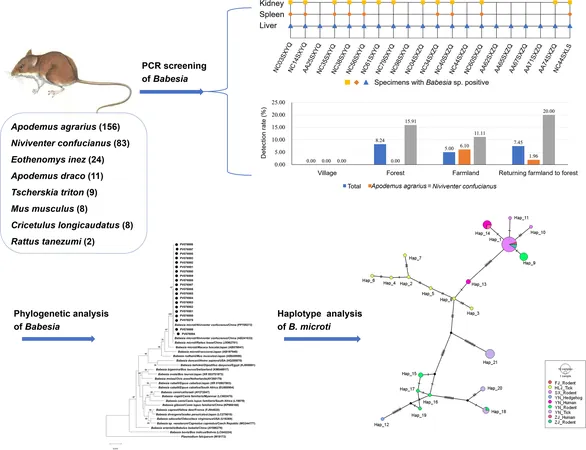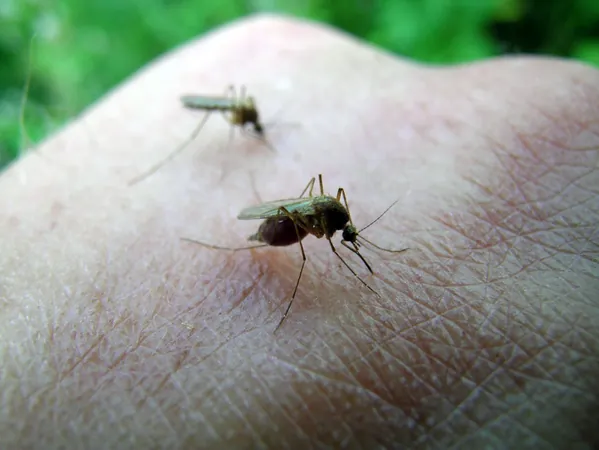
Unveiling the Threat: Babesia microti Found in Rodents of Shanxi, China
2025-06-22
Author: Emily
A Looming Danger: Babesiosis in Focus
Babesiosis, a rising global concern, is a tick-borne disease threatening the health of both humans and animals. Recent research delves into the prevalence and genetic diversity of Babesia microti in rodents throughout central and southern Shanxi Province, China.
Research Methodology: Digging Deep
Researchers trapped rodents across various regions of Shanxi, collecting liver, spleen, and kidney specimens. They utilized advanced genetic techniques, including 18S rRNA gene amplification, to identify the presence of Babesia and map its genetic landscape.
Key Findings: Rates That Raise Eyebrows
From 301 rodents examined, 20 were found infected with Babesia microti, yielding an infection rate of 6.64%. Notably, the Niviventer confucianus species showed a striking 16.87% infection prevalence, while Apodemus agrarius exhibited a 3.85% rate. The geographical disparity was significant, with central Shanxi showing a much higher rate of 9.74% compared to a mere 0.94% in southern Shanxi.
Genetic Insights: The Microti Puzzle
All sequences identified belonged to the B. microti Kobe type, which is capable of infecting humans. Interestingly, the study revealed low genetic diversity—only 21 haplotypes identified, indicating that environmental and host-specific factors heavily influenced transmission patterns.
Reservoir Rodents: The Unsung Heroes of Transmission
Among the eight rodent species captured, only Niviventer confucianus and Apodemus agrarius were hosts for Babesia microti. This highlights the critical role of N. confucianus as a reservoir species for the pathogen, underscoring its significance in ongoing surveillance.
Comparative Landscape: Babesia microti Beyond Shanxi
The detection rate of B. microti in Shanxi was found to be lower than in areas like Yunnan and Beijing, yet higher than in regions such as Fujian. This variation points to the need for focused monitoring efforts and localized control strategies.
The Genetic Highway: Pathways of Babesia microti
The study also painted a broader genetic picture of B. microti in China. With haplotypes closely related to human and rodent-derived sequences from various regions, concerns mount over potential zoonotic spillover, amplifying the urgency for public health measures.
Conclusions: A Call to Action
This investigation reveals a significant prevalence of Babesia microti among wild rodents in Shanxi, highlighting the need for robust prevention and control strategies in the region. As Babesia microti continues to expand its range, vigilance is paramount to preventing human infections and safeguarding health.
Future Directions: Bridging Knowledge Gaps
To better understand Babesia microti's spread, future research should focus on balanced sampling across different rodent species and habitats, alongside rigorous vector surveillance. Enhanced genetic analysis techniques could provide deeper insights into this evolving epidemiological challenge.









 Brasil (PT)
Brasil (PT)
 Canada (EN)
Canada (EN)
 Chile (ES)
Chile (ES)
 Česko (CS)
Česko (CS)
 대한민국 (KO)
대한민국 (KO)
 España (ES)
España (ES)
 France (FR)
France (FR)
 Hong Kong (EN)
Hong Kong (EN)
 Italia (IT)
Italia (IT)
 日本 (JA)
日本 (JA)
 Magyarország (HU)
Magyarország (HU)
 Norge (NO)
Norge (NO)
 Polska (PL)
Polska (PL)
 Schweiz (DE)
Schweiz (DE)
 Singapore (EN)
Singapore (EN)
 Sverige (SV)
Sverige (SV)
 Suomi (FI)
Suomi (FI)
 Türkiye (TR)
Türkiye (TR)
 الإمارات العربية المتحدة (AR)
الإمارات العربية المتحدة (AR)